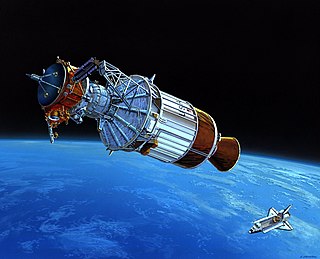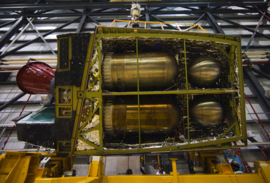
The Space Shuttle is a retired,partially reusable low Earth orbital spacecraft system operated from 1981 to 2011 by the U.S. National Aeronautics and Space Administration (NASA) as part of the Space Shuttle program. Its official program name was Space Transportation System (STS),taken from a 1969 plan for a system of reusable spacecraft where it was the only item funded for development. The first (STS-1) of four orbital test flights occurred in 1981,leading to operational flights (STS-5) beginning in 1982. Five complete Space Shuttle orbiter vehicles were built and flown on a total of 135 missions from 1981 to 2011,launched from the Kennedy Space Center (KSC) in Florida. Operational missions launched numerous satellites,interplanetary probes,and the Hubble Space Telescope (HST),conducted science experiments in orbit,participated in the Shuttle-Mir program with Russia,and participated in construction and servicing of the International Space Station (ISS). The Space Shuttle fleet's total mission time was 1,323 days.

The Centaur is a family of rocket propelled upper stages produced by U.S. launch service provider United Launch Alliance,with one main active version and one version under development. The 3.05 m (10.0 ft) diameter Common Centaur/Centaur III flies as the upper stage of the Atlas V launch vehicle,and the 5.4 m (18 ft) diameter Centaur V is being developed as the upper stage of ULA's new Vulcan rocket. Centaur was the first rocket stage to use liquid hydrogen (LH2) and liquid oxygen (LOX) propellants,a high-energy combination that is ideal for upper stages but has significant handling difficulties.

STS-1 was the first orbital spaceflight of NASA's Space Shuttle program. The first orbiter,Columbia,launched on April 12,1981,and returned on April 14,1981,54.5 hours later,having orbited the Earth 36 times. Columbia carried a crew of two—mission commander John W. Young and pilot Robert L. Crippen. It was the first American crewed space flight since the Apollo–Soyuz Test Project (ASTP) in 1975. STS-1 was also the maiden test flight of a new American spacecraft to carry a crew,though it was preceded by atmospheric testing (ALT) of the orbiter and ground testing of the Space Shuttle system.
Monomethylhydrazine is a highly toxic,volatile hydrazine derivative with the chemical formula CH3NHNH2. It is used as a rocket propellant in bipropellant rocket engines because it is hypergolic with various oxidizers such as nitrogen tetroxide and nitric acid. As a propellant,it is described in specification MIL-PRF-27404.

STS-41-C was NASA's eleventh Space Shuttle mission,and the fifth mission of Space Shuttle Challenger. The launch,which took place on April 6,1984,marked the first direct ascent trajectory for a Space Shuttle mission. During the mission,Challenger's crew captured and repaired the malfunctioning Solar Maximum Mission satellite,and deployed the Long Duration Exposure Facility (LDEF) experimental apparatus. STS-41-C was extended one day due to problems capturing the Solar Max satellite,and the landing on April 13,1984,took place at Edwards Air Force Base,instead of at Kennedy Space Center as had been planned. The flight was originally numbered STS-13.

STS-39 was the twelfth mission of the NASA Space Shuttle Discovery,and the 40th orbital shuttle mission overall. The primary purpose of the mission was to conduct a variety of payload experiments for the U.S. Department of Defense (DoD).

STS-40,the eleventh launch of Space Shuttle Columbia,was a nine-day mission in June 1991. It carried the Spacelab module for Spacelab Life Sciences 1 (SLS-1),the fifth Spacelab mission and the first dedicated solely to biology. STS-40 was the first spaceflight that included three women crew members.

A liquid-propellant rocket or liquid rocket utilizes a rocket engine that uses liquid propellants. Liquids are desirable because they have a reasonably high density and high specific impulse (Isp). This allows the volume of the propellant tanks to be relatively low. It is also possible to use lightweight centrifugal turbopumps to pump the rocket propellant from the tanks into the combustion chamber,which means that the propellants can be kept under low pressure. This permits the use of low-mass propellant tanks that do not need to resist the high pressures needed to store significant amounts of gasses,resulting in a low mass ratio for the rocket.

The Saturn IB was an American launch vehicle commissioned by the National Aeronautics and Space Administration (NASA) for the Apollo program. It uprated the Saturn I by replacing the S-IV second stage,with the S-IVB. The S-IB first stage also increased the S-I baseline's thrust from 1,500,000 pounds-force (6,700,000 N) to 1,600,000 pounds-force (7,100,000 N) and propellant load by 3.1%. This increased the Saturn I's low Earth orbit payload capability from 20,000 pounds (9,100 kg) to 46,000 pounds (21,000 kg),enough for early flight tests of a half-fueled Apollo command and service module (CSM) or a fully fueled Apollo Lunar Module (LM),before the larger Saturn V needed for lunar flight was ready.

The Space Shuttle external tank (ET) was the component of the Space Shuttle launch vehicle that contained the liquid hydrogen fuel and liquid oxygen oxidizer. During lift-off and ascent it supplied the fuel and oxidizer under pressure to the three RS-25 main engines in the orbiter. The ET was jettisoned just over 10 seconds after main engine cut-off (MECO) and it re-entered the Earth's atmosphere. Unlike the Solid Rocket Boosters,external tanks were not re-used. They broke up before impact in the Indian Ocean,away from shipping lanes and were not recovered.

The Aerojet Rocketdyne RS-25,also known as the Space Shuttle Main Engine (SSME),is a liquid-fuel cryogenic rocket engine that was used on NASA's Space Shuttle and is currently used on the Space Launch System (SLS).

The Apollo command and service module (CSM) was one of two principal components of the United States Apollo spacecraft,used for the Apollo program,which landed astronauts on the Moon between 1969 and 1972. The CSM functioned as a mother ship,which carried a crew of three astronauts and the second Apollo spacecraft,the Apollo Lunar Module,to lunar orbit,and brought the astronauts back to Earth. It consisted of two parts:the conical command module,a cabin that housed the crew and carried equipment needed for atmospheric reentry and splashdown;and the cylindrical service module which provided propulsion,electrical power and storage for various consumables required during a mission. An umbilical connection transferred power and consumables between the two modules. Just before reentry of the command module on the return home,the umbilical connection was severed and the service module was cast off and allowed to burn up in the atmosphere.

A reaction control system (RCS) is a spacecraft system that uses thrusters to provide attitude control and translation. Alternatively,reaction wheels are used for attitude control. Use of diverted engine thrust to provide stable attitude control of a short-or-vertical takeoff and landing aircraft below conventional winged flight speeds,such as with the Harrier "jump jet",may also be referred to as a reaction control system.

The pressure-fed engine is a class of rocket engine designs. A separate gas supply,usually helium,pressurizes the propellant tanks to force fuel and oxidizer to the combustion chamber. To maintain adequate flow,the tank pressures must exceed the combustion chamber pressure.

STS-122 was a NASA Space Shuttle mission to the International Space Station (ISS),flown by the Space ShuttleAtlantis. STS-122 marked the 24th shuttle mission to the ISS,and the 121st Space Shuttle flight overall.

STS-133 was the 133rd mission in NASA's Space Shuttle program;during the mission,Space Shuttle Discovery docked with the International Space Station. It was Discovery's 39th and final mission. The mission launched on 24 February 2011,and landed on 9 March 2011. The crew consisted of six American astronauts,all of whom had been on prior spaceflights,headed by Commander Steven Lindsey. The crew joined the long-duration six person crew of Expedition 26,who were already aboard the space station. About a month before lift-off,one of the original crew members,Tim Kopra,was injured in a bicycle accident. He was replaced by Stephen Bowen.

The Inertial Upper Stage (IUS),originally designated the Interim Upper Stage,was a two-stage,solid-fueled space launch system developed by Boeing for the United States Air Force beginning in 1976 for raising payloads from low Earth orbit to higher orbits or interplanetary trajectories following launch aboard a Titan 34D or Titan IV rocket as its upper stage,or from the payload bay of the Space Shuttle as a space tug.

The Space Shuttle orbiter is the spaceplane component of the Space Shuttle,a partially reusable orbital spacecraft system that was part of the discontinued Space Shuttle program. Operated from 1977 to 2011 by NASA,the U.S. space agency,this vehicle could carry astronauts and payloads into low Earth orbit,perform in-space operations,then re-enter the atmosphere and land as a glider,returning its crew and any on-board payload to the Earth.

The Johannes Kepler ATV,or Automated Transfer Vehicle 002 (ATV-002),was an uncrewed cargo spacecraft built to resupply the International Space Station (ISS). It was launched on February 16,2011 by the European Space Agency (ESA). Johannes Kepler carried propellant,air and dry cargo weighing over 7,000 kilograms (15,000 lb),and had a total mass of over 20,000 kilograms (44,000 lb),making it,at the time,the heaviest payload launched by the ESA. The spacecraft was named after the 17th-century German astronomer Johannes Kepler.

Shuttle-Centaur was a version of the Centaur upper stage rocket designed to be carried aloft inside the Space Shuttle and used to launch satellites into high Earth orbits or probes into deep space. Two variants were developed:Centaur G-Prime,which was planned to launch the Galileo and Ulysses robotic probes to Jupiter,and Centaur G,a shortened version planned for use with United States Department of Defense Milstar satellites and the Magellan Venus probe. The powerful Centaur upper stage allowed for heavier deep space probes,and for them to reach Jupiter sooner,prolonging the operational life of the spacecraft. However,neither variant ever flew on a Shuttle. Support for the project came from the United States Air Force (USAF) and the National Reconnaissance Office,which asserted that its classified satellites required the power of Centaur. The USAF agreed to pay half the design and development costs of Centaur G,and the National Aeronautics and Space Administration (NASA) paid the other half.





















